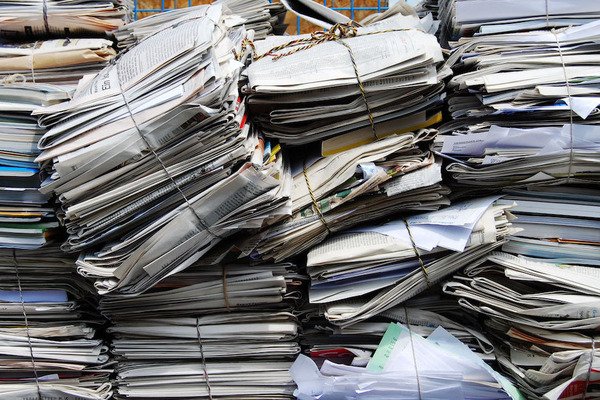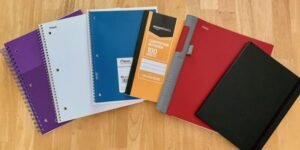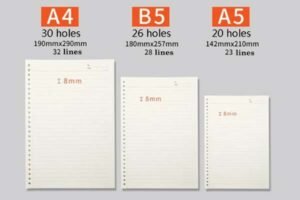
Ever finish a notebook and wonder what to do with it? Tossing it feels wasteful, especially the paper. But that metal spiral throws a wrench in the works. Can you actually recycle the whole thing easily? It's a common question we get.
Yes, you can recycle spiral notebooks1, but usually not as whole units. You typically need to separate the metal spiral wire from the paper pages and covers first, as recycling facilities process paper and metal differently.
Separating the parts is key because recycling plants are set up for specific materials. Paper goes through a process called pulping, where it's mixed with water and chemicals to break down the fibers. Metal, obviously, doesn't break down this way and can damage the paper recycling equipment or contaminate the final recycled paper pulp. That’s why most places ask you to take them apart before putting them in the bin.
So, the paper part (the pages and often the cover if it's plain cardboard) can usually go straight into your paper recycling bin. The metal spiral needs to be handled separately, often requiring you to check if your local recycling program accepts scrap metal or if there's a specific drop-off for it. It takes an extra step, but it ensures the materials actually get recycled properly.
Why is separating the spiral so important for recycling?
You might think, "It's just a small piece of wire, does it really matter?" Taking that spiral off seems like a hassle. But there’s a good reason why it's necessary for effective recycling.
Separating the metal spiral is crucial because it prevents contamination in the paper recycling stream. Metal can damage recycling machinery, lower the quality of recycled paper pulp, and can even cause entire batches of paper to be rejected and sent to landfill.

How Paper Recycling Works (Basically)
Think about how paper is made into pulp. Recycling facilities use giant machines that mix paper with water to create a slurry. Screens and filters then remove contaminants like staples or plastic bits.
- Pulping: Paper is shredded and mixed with water and chemicals.
- Screening: The pulp mixture is passed through screens to remove non-paper items.
- Cleaning & De-inking: Processes remove inks and glues.
- Pressing & Drying: The pulp is pressed into sheets and dried to make new paper.
The Problem with Metal Contamination
That metal spiral causes big problems in this system.
- Equipment Damage: Hard metal wires can jam or damage the shredders, screens, and other machinery. This means costly repairs and downtime for the facility.
- Pulp Quality: Bits of metal that sneak through contaminate the paper pulp. This makes the final recycled paper product weaker or unusable for many purposes. Imagine finding metal bits in your "recycled" paper!
- Rejected Bales: If sorters see too many notebooks with spirals still attached, they might label the entire bale of paper as contaminated. This often means the whole lot gets sent to a landfill instead of being recycled.
What About Plastic Spirals?
Plastic spirals have similar issues. While maybe less damaging to equipment than metal, plastic is still a contaminant in the paper stream. It needs to be sorted separately. Different plastic types also have different recycling requirements, adding another layer of complexity. So, separating plastic spirals is usually necessary too.
What parts of a spiral notebook can be recycled?
Okay, so we know separation is important. But what exactly goes where once you've taken your notebook apart? Let's break it down.
The paper pages and uncoated cardboard covers are typically recyclable with your regular paper waste. The metal spiral can often be recycled with scrap metal, but you must check local guidelines. Plastic covers or spirals require checking the plastic type and local recycling capabilities.
Notebook Components:
Paper Components
- Inner Pages: These are usually the easiest part. Most notebook paper is high-quality and readily recyclable. Just make sure they aren't heavily soiled with things like paint, excessive glue, or food waste.
- Pro Tip: If a few pages are really messy, it's better to tear those out and trash them to avoid contaminating the rest.
- Covers: Cardboard covers are generally recyclable with paper. However, watch out for covers with a heavy plastic coating (like a glossy finish) or embedded materials (like fabric). These often cannot be recycled with paper.
Metal Spiral
- Material: Most spirals are steel. Steel is highly recyclable.
- How to Recycle: Once removed, you usually can't just toss it in your curbside bin with cans. Check your local waste management authority's website. They might have specific instructions for scrap metal drop-off, or sometimes accept small metal items if collected separately (e.g., in a tin can).
Plastic Components
- Covers & Spirals: Some notebooks use plastic covers or spirals. Look for a recycling symbol (a number inside chasing arrows, like #5 for PP - Polypropylene).
- Local Rules are Key: Even if there's a symbol, many local programs do not accept these types of rigid plastics through curbside pickup. They might lack the facilities to sort and process them effectively. Always check locally.
Here’s a quick reference:
| Component | Material Example | Generally Recyclable? | Key Consideration |
|---|---|---|---|
| Inner Pages | Paper (80-120gsm) | Yes | Put in paper recycling bin |
| Cover (Plain) | Cardboard | Yes | Put in paper recycling bin |
| Cover (Coated) | Plastic-Laminated | Often No | Check locally; usually trash |
| Spiral Binding | Steel | Yes (as scrap metal) | Separate first; check local rules |
| Spiral Binding | Plastic (PP, PVC) | Sometimes | Check plastic # and local rules |
| Cover (Plastic) | PP, PVC | Sometimes | Check plastic # and local rules |
Are there eco-friendlier notebook options2?
Dealing with separating spirals can feel like a bit of work. If you're looking for simpler, greener alternatives, the good news is there are plenty of options available!
Yes, definitely! Consider notebooks made with recycled paper content, paper from certified sustainable sources like FSC, or designs that are easily refillable or separable, such as binder systems or notebooks with thread-sewn bindings.
Choosing a more sustainable notebook from the start can reduce waste and make disposal easier down the line.
Exploring Greener Choices:
1. High Recycled Content
- Look for notebooks specifying Post-Consumer Waste (PCW) content. This means the paper is made from materials that people like you and me have already used and recycled. It directly reduces the need for virgin tree pulp.
2. Certified Sustainable Paper
- Certifications like the Forest Stewardship Council (FSC™) ensure the paper comes from forests managed responsibly – environmentally sound, socially beneficial, and economically viable. (At NotebookRing®, we're proud our factory is FSC™ certified - C106904).
3. Refillable Binder Systems
- This is a fantastic way to reduce waste. You buy a durable cover and ring mechanism once, and then just replace the inner paper pages as needed. Systems like standard 6-hole or 26-hole binders are common and allow for lots of paper choices.
- Personal Story: [Insert brief personal story here about switching to or appreciating refillable systems, e.g., how it organized your projects or reduced your office waste].
4. Different Binding Methods Tthat Don't Use Spirals
- Sewn Binding: Creates a durable book that often lays flat. Thread is less problematic in recycling than metal or plastic.
- Glue Binding (Perfect Binding): Pages are glued together. While the glue can sometimes be a minor contaminant, it's generally less problematic than spirals for paper mills.
- Bare Spine / Exposed Stitch Binding: A variation of sewn binding that allows the book to lay completely flat (180 degrees). We developed this for a German client's botanical notebooks, and it was a huge success!
5. Eco-Conscious Materials Throughout
- Beyond paper, consider other materials. Are soy-based inks used instead of petroleum-based ones? Are covers made from alternative fibers like bagasse (sugarcane waste)? Can plastic components be biodegradable? We offer options like soy ink printing and bagasse fiber covers for clients focused on sustainability.
Looking for Sustainable & Customizable Notebooks? That's Our Specialty at NotebookRing®!
Navigating the world of eco-friendly stationery can be complex, especially when you need large quantities or specific designs for your business, school, or brand. Finding a supplier who truly understands sustainable practices and delivers high-quality, customized products isn't always easy.
That's where we come in. Since 2006, NotebookRing® has focused on manufacturing professional notebooks and binders. Based in Wenzhou, China, our 15,000㎡ FSC-certified factory is equipped to handle demanding projects while adhering to strict environmental and quality standards (ISO 9001, BSCI, REACH).
We specialize in creating solutions that meet specific needs:
- Sustainable Materials: We offer FSC-certified paper, high recycled content paper, soy inks, and even innovative materials like bagasse fiber covers.
- Flexible Binding: From metal binders (a great reusable option!) to sewn bindings and our patented seamless coils, we provide choices that align with usability and easier end-of-life management.
- Customization: Need your logo hot-stamped? Require specific inner page formats like grids or dots? Looking for bilingual printing like Sarah Müller needed for her German bookstores? We handle it all, even supporting smaller batch orders which helped James Wong in Singapore get his custom corporate gifts.
- Quality You Can Trust: Our 4-level quality inspection ensures everything from paper weight to binding strength meets high standards.
Whether you're an educational institution needing durable notebooks, a company creating unique corporate gifts, or a brand developing a special product line, we have the expertise and manufacturing capability to bring your vision to life, responsibly.
Ready to explore truly sustainable and customized notebook solutions?
Contact Timothy Wei at info@notebookring.com or visit www.notebookring.com. We offer free physical sample books and can provide an OEM proposal within 24 hours.
Conclusion
So, you can recycle spiral notebooks, but remember the key step: separate the metal or plastic spiral from the paper parts first. Check your local recycling rules for specifics. Or, consider choosing more eco-friendly options like refillable binders or FSC-certified notebooks from the start.





